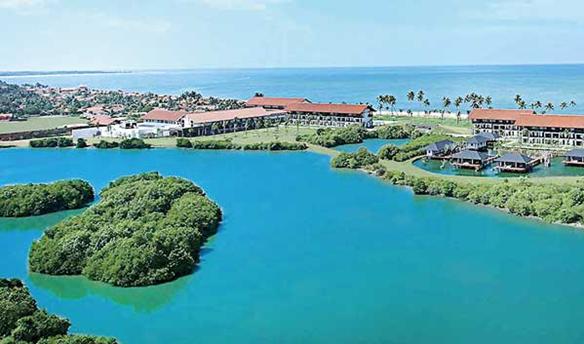There is no doubt that tourism in Sri Lanka is currently growing in leaps and bounds, with the cumulative arrivals up to April 2014 amounting to 534,132, which is an overall growth of 27 percent year-on-year (YoY). Hence, it is quite possible that the arrivals to the country will reach close upon 1.5 million arrivals or more by the end of this year.
Earnings have also kept pace with the arrival growth pattern, with 2013 achieving a record US $ 1.75 million in foreign exchange revenues. Up to April 2014, earnings have exceeded US $ 700 million already, and it would be safe to assume that by the end of the year it will reach close to the US $ 2 billion mark. The hotel sector accounts for about 65 percent of all these earnings, with the other segments being travel agencies, banks and shops registered to accept foreign currency. Fuelling and driving the dramatic changes of all these main indices are other interesting and also important emerging trends, as Sri Lanka tourism moves into becoming a mature market. Hence, it is worthwhile to analyse what some of these emerging trends in tourist arrivals are in the last two to three years.
Arrivals
The Sri Lanka Tourism Development Authority (SLTDA) statistics provide comprehensive data on several aspects of tourism and one of the more important indices available in these statistics is the foreign guest nights (FGN). This is the actual number of nights a foreign guest stays in a hotel (formal graded establishments) and in smaller informal hotels (supplementary establishments).
When this data is analysed, over the last four years, it shows an interesting phenomena, where up to in 2011 the number of foreign tourists who stayed in the smaller informal hotel sector grew at a phenomenal rate of 80 percent YoY, while the formal sector grew only by 21 percent. However, in 2013, both sectors show a healthy increase of 34.8 percent YoY in the star classified hotels and 22.5 percent YoY in the smaller establishments.
Hence, it appears that after the initial spurt in the growth of the informal sector, currently both the formal and informal sectors are growing rapidly. However, it must be noted that there is a large number of small accommodation units mushrooming up, especially in the more ‘touristic’ areas of the island. These establishments are not registered with the SLTDA and therefore totally unregulated and their data and information related to foreigners’ stays are not captured in the overall statistics. It is difficult even to make a calculated guess as to the size and performance of this segment.
Accommodation/room stock
The number of rooms in the formal sector has increased from 14,714 in 2010 to 16,223 in 2013, a 10.3 percent overall increase, with 26 new hotels coming into the operation during this period. On the other hand, the number of supplementary accommodation rooms increased from 5,895 to 7,373, which is a 25 percent increase. On an overall basis, during this period, 158 new supplementary accommodation establishments have been commissioned. This of course does not take into account the other numerous unregistered accommodation units mentioned earlier. This perhaps indicates that due to rising construction cost, possible market demands and return on investments concerns, new investors seem to be focusing on building smaller establishments with lesser number of rooms.
‘Leakage factor’
It is an accepted fact that of the total arrivals recorded each year, not every person who arrives in the country stays in a hotel. There is a large visiting friends and relatives (VFR) and diaspora segment, which does not get caught up in the accommodation statistics, although they are recorded as tourist arrivals. The hotel sector considers this segment a ‘leakage factor’.
Since, the average stay per guest is known, it is quite easy to establish the actual number of foreign guests who stay in hotels, by dividing foreign guest nights by the average stay. The number of foreigners, who actually stay in hotels and supplementary establishments, can then be compared with the overall arrival statistics of the country and the ‘leakage factor’ can be assessed. It is interesting to note that this leakage factor has increased from about 18-15 percent in 2010/11 to around 24-26 percent in the last two years. Hence, possibly, there is a larger number of visitors coming to Sri Lanka, who are Sri Lankan expatriate returnees.
Over and above this, there may be a sizable number of tourists who are staying in the many smaller unregistered accommodation units in the island whose data is not reflected in the SLTDA statistics by virtue of the fact that they are unregistered and could be a part of this ‘leakage factor’.
Other revenue from tourism
Many of the country’s natural and other attractions draw a large number of tourists and consequently there is revenue earned by these sectors as well. The main locations are the wildlife parks, zoo, cultural sites, botanical gardens and museums from which the state earned around US $ 20 million in 2012. It is noteworthy that all of these sites show healthy increases in earnings from tourists over the past few years, with wildlife parks leading the growth with over 300 percent growth over the past four years. This indicates that Sri Lanka has the potential to further develop wildlife tourism greatly, while at the same time other attractions also must be further developed and enhanced to give a better visitor experience.
Conclusion
Hence, it is important that tourism professionals and in particular, hotel operators and developers look at these emerging trends in a more analytical manner, so that Sri Lanka’s future product and service offerings can be geared to suit the market demands.
Source: http://www.dailymirror.lk/business/features/47682-changing-face-of-sri-lanka-tourism.html

